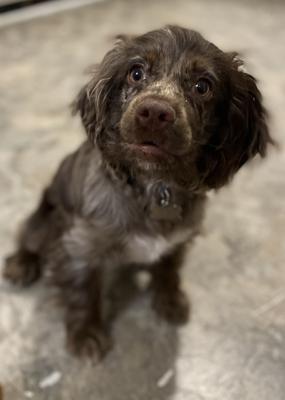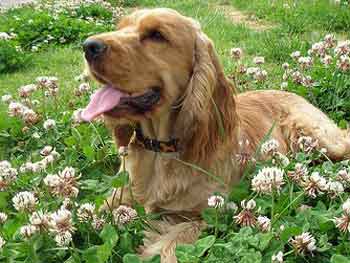- Home
- Cocker Spaniel Information
- English Cocker Spaniel Breed
An Introduction to the Cocker Spaniel Breed
The English Cocker Spaniel breed is so delightful!
Find out all you need to know about this gorgeous dog breed; their attractive characteristics and gentle temperament, health care issues they may face during their lifetime, training requirements, and more.
Enjoy!
The English Cocker Spaniel Breed
Cocker Spaniel Breeds: Working and Show Cockers
Working Cocker Spaniel
The working Cocker and show Cocker look distinctly different.
The working Cocker is slightly taller, their coats are more lightly feathered, and they have a flatter skull.
They are traditionally used for hunting and field sporting events.
Working cockers are energetic and tend to run from A to B at full speed. If they aren't used for field work, they will need additional exercise and lots of stimulation to keep them happy.
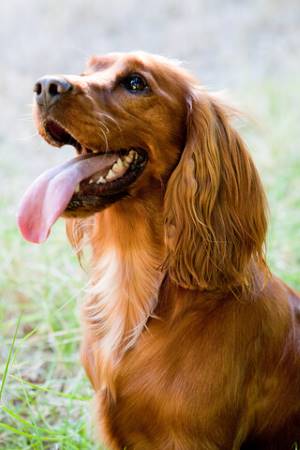 A lovely example of the Cocker Spaniel breed!
A lovely example of the Cocker Spaniel breed!The Show Cocker Spaniel
The show Cocker is precisely that; it's paraded in a show ring, often winning prizes for its beauty and agility.
However, it's not unheard of for show Cockers to be used for sport in the field; show Spaniels are sometimes used as hunting dogs.
Show Cockers don't need as much exercise but love to sniff around in the undergrowth; they don't feel the need to chase as much as a working Cocker.
Strong, Sturdy Dogs!
Cocker Spaniels are solid and stocky; their bodies are robust and compact, and have a well-developed, deep chest.
Their hindquarters are sturdy, round and plump, and they have strong, muscular back legs, which helps them be swift runners.
You'll know what I mean if you've ever seen a Cocker run after a rabbit.
Ideal Height & Weight
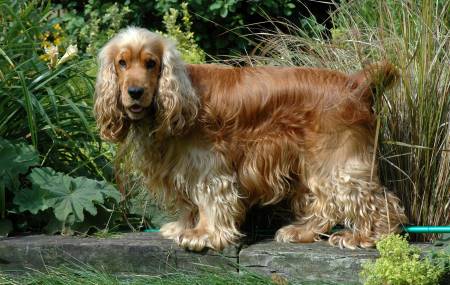 I can see crested newts in the pond!
I can see crested newts in the pond!Cockers are classed as medium-sized dog breeds, somewhere between 39 and 41 cm in height (15-16") for the males, and the bitch is slightly smaller at around 38 to 39 cm (15-15.5").
Their ideal weight is around 12 to 14.5 kg, depending on age, sex and build, but they're prone to weight gain as they age.
My Cocker is getting on in years and is towards the top end of this weight guide. I'm constantly watching his food intake, keeping treats to a minimum, and giving him lots of praise and cuddles instead.
The Cocker's Head
The English Cocker Spaniel breed has a well-developed skull. Their heads have a gently rounded, domed look, slightly flat on top, and their muzzle is more square than sharply pointed.
Cocker Spaniel Ears
Cockers have long, pendulous ears set relatively low on each side of the head, about level with their eyes.
These gorgeous ears are covered in luxuriously long, soft, silky hair, making them almost cartoon-like.
Cocker Spaniel Eyes
Cockers have very appealing eyes, usually brown, but can sometimes be hazel, depending upon the dog's coat colour.
They're beautifully expressive, liquid pools of endearment that can melt your heart!
The Cocker Spaniel Dog Breed Has A Strong Neck!
The Cocker Spaniel breed has quite a muscular neck and can be surprisingly strong if he pulls on the lead, which they're prone to do unless you train them very early to walk to heel.
And even then, there's no guarantee your dog won't pull on the lead!
Bear-like Paws!
Cocker paws are pretty well padded and cat-like, and when in dire need of trimming, all that fur can make their feet look enormous!
I love Max's paws when they look like bear paws, but I always keep the fur between their underside trimmed level with the pads.
Cocker Spaniel Tails
Cocker tails used to be docked, usually within the first week of birth, but in many countries, this is now banned (with certain exceptions).
If you own a Cocker Spaniel, you'll know that this tail (or stump) hardly ever stops wagging! You can learn more about docking puppy tails here.
Cocker Spaniel Breed: Coat Colours
Cockers can be seen in many coat colours; golden, red, black, brown, black and white, liver and white, red and white, black roan, orange roan, blue roan, tricolours and parti-colours.
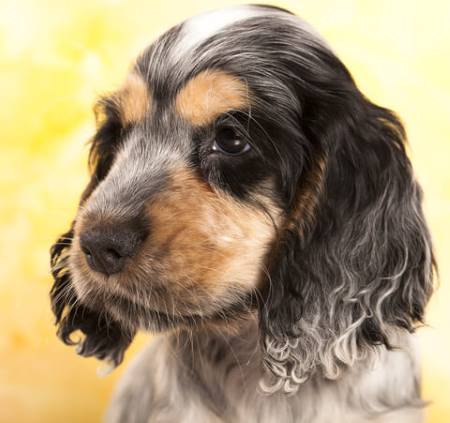 I'm a lovely example of a Cocker Spaniel!
I'm a lovely example of a Cocker Spaniel!They have a short undercoat and a fine topcoat.
The topcoat is straight but sometimes slightly wavy and is luxuriously silky in texture. Cockers are often heavily feathered on the legs, body, chest and ears.
In show circles, it's considered a 'fault' if the coat texture is woolly or thick, like cotton wool, or is too wavy, but if you're not showing your dog and he's the family pet, who cares?
I may have already mentioned this, but chocolate and golden cocker spaniels are my favourites!
Cocker Spaniel Breed: Grooming
It's true to say that Cockers need a regular grooming routine to keep their coat healthy-looking and in good condition.
For the best results, and if you can afford it, I recommend having your Cocker's coat hand-stripped by a professional groomer to help keep that luxurious silkiness. (Make sure the groomer has plenty of experience with Cockers).
The feathers can be given the occasional light trim where necessary.
It's best to stay on top of your pet's grooming and do a little each day; otherwise, it may be too much for you (and your dog).
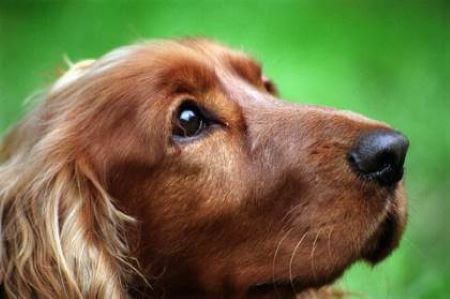 Attentive Cocker waiting for his next command
Attentive Cocker waiting for his next commandWithout a strict grooming regime, your dog's coat may end up full of mats that can be difficult to remove and may need to be cut away. If matting is allowed to get out of hand, your dog may need to be completely shaved!
In severe cases, for example, where a rescue dog has been badly neglected, the matting may have become so extensive and is too close to the body that the vet may need to remove the dog's coat under anaesthetic!
If your Cocker has been castrated (or spayed), his coat may become thick, like cotton wool, as he slowly loses his silky coat. So although neutering a dog has many benefits, there are one or two downsides too!
Unfortunately, once the silky topcoat has been removed with an electric trimmer, it never grows back in the same way, so if you want to keep your Cocker's beautiful coat looking beautiful, hand stripping (or a very light trimming) is your only option.
Many owners find such a grooming routine too much for them. They take their pets to a professional groomer for a 'Cocker cut' every 3 months to keep them looking like they should.
But if you're brave enough, you should learn how to do it yourself.
Grooming your Spaniel should take at most 30 minutes each day, and it can be very relaxing for you both and can help you bond with your dog.
The Cocker Spaniel Breed Standard
The Cocker Spaniel breed standard outlines the desired appearance and characteristics defined by the American Kennel Club and the UK Kennel Club.
Professional Cocker Spaniel breeders follow this standard to ensure the breed remains true and will only breed from carefully selected, DNA tested and near-perfect dogs and bitches.
Health Concerns
The Cocker Spaniel breed has a lifespan of between 10 and 12 years (although many Spaniels live longer, up to 15 years!).
During this lifetime, they may be susceptible to specific eye problems, so it's best to understand what can go wrong and what you can do to ensure your Cocker has healthy eyes.
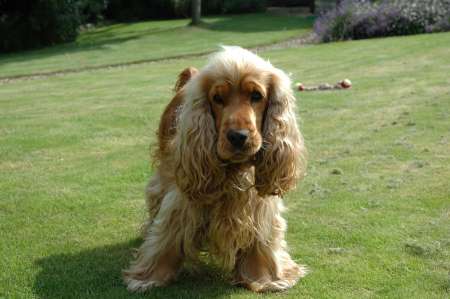 Come on Mum, just one more game!
Come on Mum, just one more game!Their ears, by design, don't get enough air circulation, the lack of which creates warm, moist, dark conditions inside the ear (an ideal breeding ground for bacteria), so checking and cleaning their ears often is very important if you're to keep infections at bay.
As caring owners, our Cocker Spaniel's health is important to us.
Most health problems can be avoided simply by taking good care of pets, regular trips to the vet, a healthy diet and lots of exercise.
Oh, and lots of TLC too!
Cocker Spaniel Breed: Temperament
It's universally known and accepted that the Cocker Spaniel's temperament is terrific!
They're a very gentle and loving breed. They are excellent companions, and because they're great with children, they also make good family dogs!
They're intelligent, making them very easy to train, but they can be stubborn or strong-willed and may need firm, confident handling.
Conversely, Cockers can also be timid, in which case they will need gentle handling and training, with lots of early socialisation to help give them confidence.
This is a general statement, but I firmly believe timid Cockers that haven't been adequately socialised can grow into fear biters.
Socialisation is an essential part of a young puppy's training!
Cocker Spaniel Breed Characteristics
Cocker Spaniel's characteristics are very endearing; it's a handsome, willing, and delightful little dog.
They're remarkably gentle and happy in nature. Their little tails never stop wagging, and they love to frolic and play, no matter what!
In fact, their happy nature has earned them the nickname of 'The Merry Cocker'.
You can often see the Spaniel with his bottom in the air, tail wagging furiously, head sniffing the ground following the scent of a rabbit, utterly oblivious to everything else around him!
I'm undoubtedly biased, but the Cocker Spaniel breed is the best! If you're ready to give a puppy (or a dog) a loving home, you will do well to consider one of these.
Why not visit your local Cocker Spaniel rescue or dog adoption centre and see what they offer? I'm sure you won't regret it!
If you'd rather use a breeder, why not look at this article which explains how to find a good breeder? And this page will give you a heads-up on which questions to ask.
Whatever you decide, enjoy your Cocker Spaniel for many years to come!
Photo Credits for Cocker Spaniel Breed:
1. Michelle De Kock at https://www.dreamstime.com/english-cocker-spaniel-image13579192
2. Web author's own photograph
3. Liliya Kulianionak at https://www.dreamstime.com/royalty-free-stock-images-puppy-english-cocker-spaniel-image23622039
4. Daniel Leppens at https://www.dreamstime.com/cocker-spaniel-image3811265
5. Web author's own photograph

